Pricing Guides & Dictionary of Makers Marks for Antiques & Collectibles

A few examples of appraisal values for
NEW MEXICO CELT AXE
Search our price guide for your own treasures
-
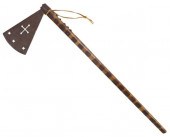 NATIVE AMERICAN STYLE AXE, 20TH/
NATIVE AMERICAN STYLE AXE, 20TH/ 21ST C.Modern Native American style axe, 20th/ 21st c., the axe head with four cutouts including a cross, the handle decorated with brass tacks and apparent darkened filed squares on the handles three sixes, axe head approx. 5"h, 9"w, overall with handle: approx. 28"h, 1.75lbs
NATIVE AMERICAN STYLE AXE, 20TH/
NATIVE AMERICAN STYLE AXE, 20TH/ 21ST C.Modern Native American style axe, 20th/ 21st c., the axe head with four cutouts including a cross, the handle decorated with brass tacks and apparent darkened filed squares on the handles three sixes, axe head approx. 5"h, 9"w, overall with handle: approx. 28"h, 1.75lbs -
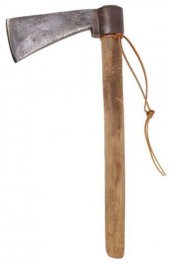 NATIVE AMERICAN STYLE AXE, 20TH/
NATIVE AMERICAN STYLE AXE, 20TH/ 21ST C.Modern Native American style axe, 20th/ 21st c. with hand-forged head stamped S B, the axe head approx, 3.5"h, 9"w, with wood handle approx. 18.75"h, 3.75lbs
NATIVE AMERICAN STYLE AXE, 20TH/
NATIVE AMERICAN STYLE AXE, 20TH/ 21ST C.Modern Native American style axe, 20th/ 21st c. with hand-forged head stamped S B, the axe head approx, 3.5"h, 9"w, with wood handle approx. 18.75"h, 3.75lbs -
 NATIVE AMERICAN METAL TRADE
NATIVE AMERICAN METAL TRADE AXEAntique metal trade ax with wooden handle. Hand forged, double sided head. Excellent condition with moderate wear from use. Provenance: Consignor obtained the piece from a sale of the personal artifacts collection of Jerome Peltier, a founder of the Museum of Native American Cultures and author of more than a dozen books on Western history. Measures 13" long x 6 7/8" wide.
NATIVE AMERICAN METAL TRADE
NATIVE AMERICAN METAL TRADE AXEAntique metal trade ax with wooden handle. Hand forged, double sided head. Excellent condition with moderate wear from use. Provenance: Consignor obtained the piece from a sale of the personal artifacts collection of Jerome Peltier, a founder of the Museum of Native American Cultures and author of more than a dozen books on Western history. Measures 13" long x 6 7/8" wide. -
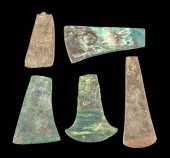 5 AZTEC COPPER TEPOZTLI AXE
5 AZTEC COPPER TEPOZTLI AXE HEADSPre-Columbian, Mexico City region, Aztec (Mexica), ca. 1300 to 1500 CE. A fine collection of 5 copper axe heads of several shapes. The 2 widest have a straight spine and a blade edge that curves slightly along the bottom. The blade with a heavy green patina and mineral deposits has a tapering butt and a head that ends in a broad curve with flared tips. In Aztec culture metal and stone heads were sometimes known as a "tepoztli," the blade component of a "tlaximaltepoztli"- an axe for utilitarian and ceremonial use. The last 2 blades have signs of use with a nicks and abrasions along both blade and butt. Larger axes were used in battle, while ones of these sizes were used as currency or ceremonially. Size of longest: 5.25" L x 1.65" W (13.3 cm x 4.2 cm) Provenance: private Fayetteville, Arkansas, USA collection; ex-Dr. David Harner collection, Springdale, Arkansas, USA, acquired between the 1950s and 1960s All items legal to buy/sell under U.S. Statute covering cultural patrimony Code 2600, CHAPTER 14, and are guaranteed to be as described or your money back. A Certificate of Authenticity will accompany all winning bids. PLEASE NOTE: Due to recent increases of shipments being seized by Australian & German customs (even for items with pre-UNESCO provenance), we will no longer ship most antiquities and ancient Chinese art to Australia & Germany. For categories of items that are acceptable to ship to Australia or Germany, please contact us directly or work with your local customs brokerage firm. Display stands not described as included/custom in the item description are for photography purposes only and will not be included with the item upon shipping. #167574 Condition: Losses to butt end of one blade as shown. Surface abrasions and nicks to other blade as expected with age and use. Blade with flared tip has a heavy, weathered surface with mineral deposits and encrustations. Green and russet patina on all blades.
5 AZTEC COPPER TEPOZTLI AXE
5 AZTEC COPPER TEPOZTLI AXE HEADSPre-Columbian, Mexico City region, Aztec (Mexica), ca. 1300 to 1500 CE. A fine collection of 5 copper axe heads of several shapes. The 2 widest have a straight spine and a blade edge that curves slightly along the bottom. The blade with a heavy green patina and mineral deposits has a tapering butt and a head that ends in a broad curve with flared tips. In Aztec culture metal and stone heads were sometimes known as a "tepoztli," the blade component of a "tlaximaltepoztli"- an axe for utilitarian and ceremonial use. The last 2 blades have signs of use with a nicks and abrasions along both blade and butt. Larger axes were used in battle, while ones of these sizes were used as currency or ceremonially. Size of longest: 5.25" L x 1.65" W (13.3 cm x 4.2 cm) Provenance: private Fayetteville, Arkansas, USA collection; ex-Dr. David Harner collection, Springdale, Arkansas, USA, acquired between the 1950s and 1960s All items legal to buy/sell under U.S. Statute covering cultural patrimony Code 2600, CHAPTER 14, and are guaranteed to be as described or your money back. A Certificate of Authenticity will accompany all winning bids. PLEASE NOTE: Due to recent increases of shipments being seized by Australian & German customs (even for items with pre-UNESCO provenance), we will no longer ship most antiquities and ancient Chinese art to Australia & Germany. For categories of items that are acceptable to ship to Australia or Germany, please contact us directly or work with your local customs brokerage firm. Display stands not described as included/custom in the item description are for photography purposes only and will not be included with the item upon shipping. #167574 Condition: Losses to butt end of one blade as shown. Surface abrasions and nicks to other blade as expected with age and use. Blade with flared tip has a heavy, weathered surface with mineral deposits and encrustations. Green and russet patina on all blades. -
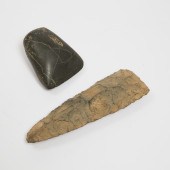 Two Pre-Columbian Stone Axe Heads
Two Pre-Columbian Stone Axe Heads (Celts), Costa Rica longer length 6.1 in — 15.5 cm
Two Pre-Columbian Stone Axe Heads
Two Pre-Columbian Stone Axe Heads (Celts), Costa Rica longer length 6.1 in — 15.5 cm -
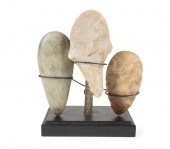 THREE PRE-COLUMBIAN STONE AXE
THREE PRE-COLUMBIAN STONE AXE HEADSThree Pre-Columbian Stone Axe Heads , pre 1500 A.D., incl. greenstone celt, and two flint, tallest h. 6 1/4 in Provenance: Collection of Brooke and Maria Fox, Metairie, LA
THREE PRE-COLUMBIAN STONE AXE
THREE PRE-COLUMBIAN STONE AXE HEADSThree Pre-Columbian Stone Axe Heads , pre 1500 A.D., incl. greenstone celt, and two flint, tallest h. 6 1/4 in Provenance: Collection of Brooke and Maria Fox, Metairie, LA -
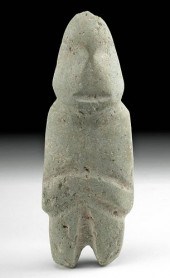 GUERRERO MEZCALA STONE AXE
GUERRERO MEZCALA STONE AXE GODPre-Columbian, Southern Mexico, Guerrero region, Mezcala culture, ca. 600 to 100 BCE. A hand-carved stone axe god figure, of characteristically abstract form, standing atop a pair of string-cut legs. Shallow string-cut grooves define the arms and waistline while additional grooves constitute the mouth, eyes, and neckline. Scholars believe figures like this were created after a utilitarian stone axe head became broken or otherwise unusable. Size: 3" W x 8.5" H (7.6 cm x 21.6 cm) Provenance: private Fort Lauderdale, Florida, USA collection; ex-Minerva Gallery; ex-Benjamin Vega, California, USA, acquired in 2006 to 2007; ex-Gene and Virginia George, brought to the USA from 1961 to 1966 All items legal to buy/sell under U.S. Statute covering cultural patrimony Code 2600, CHAPTER 14, and are guaranteed to be as described or your money back. A Certificate of Authenticity will accompany all winning bids. We ship worldwide and handle all shipping in-house for your convenience. #177918 Condition: Minor nicks and abrasions commensurate with age, with scattered areas of roughness, otherwise intact and very good. Nice surface smoothness in most areas.
GUERRERO MEZCALA STONE AXE
GUERRERO MEZCALA STONE AXE GODPre-Columbian, Southern Mexico, Guerrero region, Mezcala culture, ca. 600 to 100 BCE. A hand-carved stone axe god figure, of characteristically abstract form, standing atop a pair of string-cut legs. Shallow string-cut grooves define the arms and waistline while additional grooves constitute the mouth, eyes, and neckline. Scholars believe figures like this were created after a utilitarian stone axe head became broken or otherwise unusable. Size: 3" W x 8.5" H (7.6 cm x 21.6 cm) Provenance: private Fort Lauderdale, Florida, USA collection; ex-Minerva Gallery; ex-Benjamin Vega, California, USA, acquired in 2006 to 2007; ex-Gene and Virginia George, brought to the USA from 1961 to 1966 All items legal to buy/sell under U.S. Statute covering cultural patrimony Code 2600, CHAPTER 14, and are guaranteed to be as described or your money back. A Certificate of Authenticity will accompany all winning bids. We ship worldwide and handle all shipping in-house for your convenience. #177918 Condition: Minor nicks and abrasions commensurate with age, with scattered areas of roughness, otherwise intact and very good. Nice surface smoothness in most areas. -
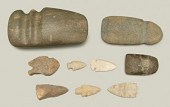 Native American stone artifacts:
Native American stone artifacts: double-grooved axe, 7-5/8 in.; single-grooved axe, 6 in., possibly a modern copy ; 3-1/4 in. celt with taped Indian head penny; five projectile points, one with broken stem, other minor losses , one cutting tool, 1-7/8 in. to 3 in., (nine pieces).
Native American stone artifacts:
Native American stone artifacts: double-grooved axe, 7-5/8 in.; single-grooved axe, 6 in., possibly a modern copy ; 3-1/4 in. celt with taped Indian head penny; five projectile points, one with broken stem, other minor losses , one cutting tool, 1-7/8 in. to 3 in., (nine pieces). -
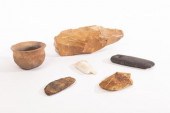 A collection of Neolithic tools,
A collection of Neolithic tools, comprising a polished trapezoid axe head, probably Danish, 8.5cm, another axe head in basalt, 13.8cm, a Mesolithic axe head, 10.5cm, a flat blade or scraper, 11cm, and a large Neolithic flint core, 5000-2500 BC, probably from Le Grand-Pressigny, worked all over with the removal of numerous flakes, 22.5cm long, together with a Bronze Age style pottery beaker, 10.5cm, origin unknown although said to be from Shropshire (6)/Provenance: from the Henry Sandon Study Col
A collection of Neolithic tools,
A collection of Neolithic tools, comprising a polished trapezoid axe head, probably Danish, 8.5cm, another axe head in basalt, 13.8cm, a Mesolithic axe head, 10.5cm, a flat blade or scraper, 11cm, and a large Neolithic flint core, 5000-2500 BC, probably from Le Grand-Pressigny, worked all over with the removal of numerous flakes, 22.5cm long, together with a Bronze Age style pottery beaker, 10.5cm, origin unknown although said to be from Shropshire (6)/Provenance: from the Henry Sandon Study Col -
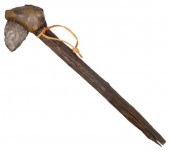 NATIVE AMERICAN STYLE CLUB AXE,
NATIVE AMERICAN STYLE CLUB AXE, 20TH/ 21ST C.Native American style axe, 20th/ 21st c., the head with a worked stone set into sewn leather exterior, head approx. 4.25"h, 2.7/8"w, stone 2.75"h, 2.5"w, including handle: 23.5"h, 1lb
NATIVE AMERICAN STYLE CLUB AXE,
NATIVE AMERICAN STYLE CLUB AXE, 20TH/ 21ST C.Native American style axe, 20th/ 21st c., the head with a worked stone set into sewn leather exterior, head approx. 4.25"h, 2.7/8"w, stone 2.75"h, 2.5"w, including handle: 23.5"h, 1lb -
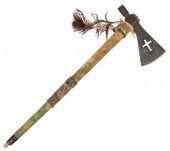 NATIVE AMERICAN STYLE PIPE AXE,
NATIVE AMERICAN STYLE PIPE AXE, 20TH/ 21ST C.Modern Native American style pipe axe, 20th/ 21st c., forged with a cutout cross, mounted on a painted handle with beads and feathers, axe hex overall approx. 4"h, 9"w, with handle: 25"h, 1.5lbs
NATIVE AMERICAN STYLE PIPE AXE,
NATIVE AMERICAN STYLE PIPE AXE, 20TH/ 21ST C.Modern Native American style pipe axe, 20th/ 21st c., forged with a cutout cross, mounted on a painted handle with beads and feathers, axe hex overall approx. 4"h, 9"w, with handle: 25"h, 1.5lbs -
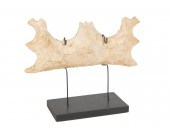 PRE-COLUMBIAN FLINT DOUBLE-AXE
PRE-COLUMBIAN FLINT DOUBLE-AXE HEADPre-Columbian Flint Double-Axe Head , pre 1500 A.D., h. 4 in., w. 9 in., d. 1 in Provenance: Collection of Brooke and Maria Fox, Metairie, LA
PRE-COLUMBIAN FLINT DOUBLE-AXE
PRE-COLUMBIAN FLINT DOUBLE-AXE HEADPre-Columbian Flint Double-Axe Head , pre 1500 A.D., h. 4 in., w. 9 in., d. 1 in Provenance: Collection of Brooke and Maria Fox, Metairie, LA -
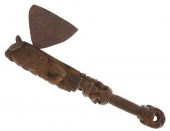 MAORI POLYNESIAN HAND CARVED
MAORI POLYNESIAN HAND CARVED CEREMONIAL AXEFeatured in this lot is this Maori Polynesian hand carved ceremonial axe. The axe features a wonderfully and professionally crafted wooden and iron construction. The handle is expertly hand carved with texturing throughout with a Maori warrior figure correctly seen at the top half of the handle with a lizard shown on the pommel of the handle. The condition of this Maori axe shows some natural fissures to the carved handle of the axe and the blade shows heavy oxidation due to exposure. The measurements of this axe is 21" x 8" x 2 3/4". The collective weight of this axe is 2lb 6oz.
MAORI POLYNESIAN HAND CARVED
MAORI POLYNESIAN HAND CARVED CEREMONIAL AXEFeatured in this lot is this Maori Polynesian hand carved ceremonial axe. The axe features a wonderfully and professionally crafted wooden and iron construction. The handle is expertly hand carved with texturing throughout with a Maori warrior figure correctly seen at the top half of the handle with a lizard shown on the pommel of the handle. The condition of this Maori axe shows some natural fissures to the carved handle of the axe and the blade shows heavy oxidation due to exposure. The measurements of this axe is 21" x 8" x 2 3/4". The collective weight of this axe is 2lb 6oz. -
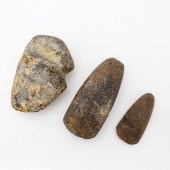 THREE NATIVE AMERICAN STONE TOOLS /
THREE NATIVE AMERICAN STONE TOOLS / AX HEADS Native American, possibly prehistoric. Three polished stone celts / ax heads. One with indent for twine. Unmarked. Approx. length 5.75" (largest), length 3.875" (smallest).
THREE NATIVE AMERICAN STONE TOOLS /
THREE NATIVE AMERICAN STONE TOOLS / AX HEADS Native American, possibly prehistoric. Three polished stone celts / ax heads. One with indent for twine. Unmarked. Approx. length 5.75" (largest), length 3.875" (smallest). -
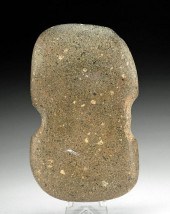 RARE ANCESTRAL PUEBLOAN STONE AXE
RARE ANCESTRAL PUEBLOAN STONE AXE HEAD, EX MUSEUMNative American, Southwestern United States, southern Colorado, Ancestral Puebloan, (Anasazi), Pueblo I to Pueblo III period, ca. 750 to 1300 CE. This is a hand-pecked and polished stone axe or hammer head, with a pair of side notches for hafting. The head is divided into separate heads by the large notches opposite each other along the periphery - one notch is slightly larger than the other - and looking closely it has a slightly raised central ridge. These notches facilitated hafting to a pole with a cord, or directly to a branch that was still green and pliable. One head is clearly the axe blade - the tip is sharpened to a cutting edge. The butt end is thicker and rounded, ideal for use as a hammer or club. Size: 5.5" L x 3.25" W (14 cm x 8.3 cm) Provenance: ex-Joan Shaw collection, purchased in 1971; loaned to the Mesa Verde Museum from 1962 to 1970, catalog no. 8562; ex-Bill Mitchell collection Cortez, Colorado, USA, from 1958 to 1962 All items legal to buy/sell under U.S. Statute covering cultural patrimony Code 2600, CHAPTER 14, and are guaranteed to be as described or your money back. A Certificate of Authenticity will accompany all winning bids. PLEASE NOTE: Due to recent increases of shipments being seized by Australian & German customs (even for items with pre-UNESCO provenance), we will no longer ship most antiquities and ancient Chinese art to Australia & Germany. For categories of items that are acceptable to ship to Australia or Germany, please contact us directly or work with your local customs brokerage firm. Display stands not described as included/custom in the item description are for photography purposes only and will not be included with the item upon shipping. #147768 Condition: Minor surface wear and nicks, and chip to blade edge that are all consistent with use and age. Intact and excellent with defined notches and smooth surface. Old inventory number on surface.
RARE ANCESTRAL PUEBLOAN STONE AXE
RARE ANCESTRAL PUEBLOAN STONE AXE HEAD, EX MUSEUMNative American, Southwestern United States, southern Colorado, Ancestral Puebloan, (Anasazi), Pueblo I to Pueblo III period, ca. 750 to 1300 CE. This is a hand-pecked and polished stone axe or hammer head, with a pair of side notches for hafting. The head is divided into separate heads by the large notches opposite each other along the periphery - one notch is slightly larger than the other - and looking closely it has a slightly raised central ridge. These notches facilitated hafting to a pole with a cord, or directly to a branch that was still green and pliable. One head is clearly the axe blade - the tip is sharpened to a cutting edge. The butt end is thicker and rounded, ideal for use as a hammer or club. Size: 5.5" L x 3.25" W (14 cm x 8.3 cm) Provenance: ex-Joan Shaw collection, purchased in 1971; loaned to the Mesa Verde Museum from 1962 to 1970, catalog no. 8562; ex-Bill Mitchell collection Cortez, Colorado, USA, from 1958 to 1962 All items legal to buy/sell under U.S. Statute covering cultural patrimony Code 2600, CHAPTER 14, and are guaranteed to be as described or your money back. A Certificate of Authenticity will accompany all winning bids. PLEASE NOTE: Due to recent increases of shipments being seized by Australian & German customs (even for items with pre-UNESCO provenance), we will no longer ship most antiquities and ancient Chinese art to Australia & Germany. For categories of items that are acceptable to ship to Australia or Germany, please contact us directly or work with your local customs brokerage firm. Display stands not described as included/custom in the item description are for photography purposes only and will not be included with the item upon shipping. #147768 Condition: Minor surface wear and nicks, and chip to blade edge that are all consistent with use and age. Intact and excellent with defined notches and smooth surface. Old inventory number on surface. -
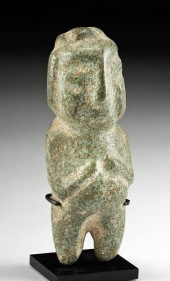 GUERRERO MEZCALA GREENSTONE TYPE
GUERRERO MEZCALA GREENSTONE TYPE M-22 AXE GOD FIGUREPre-Columbian, Southern Mexico, Guerrero region, Mezcala culture, ca. 400 to 100 BCE. A large and pretty example of a hand-carved greenstone axe god of the Type M-22 that presents with abstract anthropomorphic features. The stylized figure stands with delineated, string-cut legs and holds both arms atop the slightly bulging stomach. A rounded chest with angular shoulders and a broad neck supports the oversized, bulbous head. The minimalist visage exhibits string-cut grooves denoting the eyes and brows, nasolabial folds, and mouth. The top of the head has clefts to indicate a headdress or coiffure, and two slight tabs below the bulging forehead add the appearance of ears. The stone is a smooth mottled green-gray hue with brown speckles and beige mineral deposits. Size: 5.25" L x 2" W (13.3 cm x 5.1 cm); 5.5" H (14 cm) on included custom stand. This particular Mezcala axe god exhibits features characteristic of M-22/M-24 Mezcala figures. The Mezcala style underwent a gradual evolutionary process, and M-22/M-24 were among the most advanced of the Mezcala types. The Mezcala sculptors brilliantly used string-saw technology to differentiate facial features and limbs. The ancient artisans of this region were particularly adept at reducing the human body to eloquent, minimalist forms via this string cut technique. The result ironically appeals to a modernist taste for minimalism. Mezcala sculptural works are equally appealing for the inherent beauty of the stone selected by the ancients Provenance: private New York, New York, USA collection; ex private L.M. collection, Illinois, USA, by inheritance 1990s All items legal to buy/sell under U.S. Statute covering cultural patrimony Code 2600, CHAPTER 14, and are guaranteed to be as described or your money back. A Certificate of Authenticity will accompany all winning bids. PLEASE NOTE: Due to recent increases of shipments being seized by Australian & German customs (even for items with pre-UNESCO provenance), we will no longer ship most antiquities and ancient Chinese art to Australia & Germany. For categories of items that are acceptable to ship to Australia or Germany, please contact us directly or work with your local customs brokerage firm. Display stands not described as included/custom in the item description are for photography purposes only and will not be included with the item upon shipping. #167967 Condition: Intact and excellent. Minor abrasions. Light mineral and earthen deposits on surface. Polished and nice coloration throughout.
GUERRERO MEZCALA GREENSTONE TYPE
GUERRERO MEZCALA GREENSTONE TYPE M-22 AXE GOD FIGUREPre-Columbian, Southern Mexico, Guerrero region, Mezcala culture, ca. 400 to 100 BCE. A large and pretty example of a hand-carved greenstone axe god of the Type M-22 that presents with abstract anthropomorphic features. The stylized figure stands with delineated, string-cut legs and holds both arms atop the slightly bulging stomach. A rounded chest with angular shoulders and a broad neck supports the oversized, bulbous head. The minimalist visage exhibits string-cut grooves denoting the eyes and brows, nasolabial folds, and mouth. The top of the head has clefts to indicate a headdress or coiffure, and two slight tabs below the bulging forehead add the appearance of ears. The stone is a smooth mottled green-gray hue with brown speckles and beige mineral deposits. Size: 5.25" L x 2" W (13.3 cm x 5.1 cm); 5.5" H (14 cm) on included custom stand. This particular Mezcala axe god exhibits features characteristic of M-22/M-24 Mezcala figures. The Mezcala style underwent a gradual evolutionary process, and M-22/M-24 were among the most advanced of the Mezcala types. The Mezcala sculptors brilliantly used string-saw technology to differentiate facial features and limbs. The ancient artisans of this region were particularly adept at reducing the human body to eloquent, minimalist forms via this string cut technique. The result ironically appeals to a modernist taste for minimalism. Mezcala sculptural works are equally appealing for the inherent beauty of the stone selected by the ancients Provenance: private New York, New York, USA collection; ex private L.M. collection, Illinois, USA, by inheritance 1990s All items legal to buy/sell under U.S. Statute covering cultural patrimony Code 2600, CHAPTER 14, and are guaranteed to be as described or your money back. A Certificate of Authenticity will accompany all winning bids. PLEASE NOTE: Due to recent increases of shipments being seized by Australian & German customs (even for items with pre-UNESCO provenance), we will no longer ship most antiquities and ancient Chinese art to Australia & Germany. For categories of items that are acceptable to ship to Australia or Germany, please contact us directly or work with your local customs brokerage firm. Display stands not described as included/custom in the item description are for photography purposes only and will not be included with the item upon shipping. #167967 Condition: Intact and excellent. Minor abrasions. Light mineral and earthen deposits on surface. Polished and nice coloration throughout. -
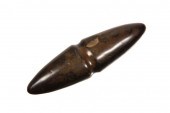 EXCEPTIONAL MESOAMERICAN POLISHED
EXCEPTIONAL MESOAMERICAN POLISHED BLACK STONE NOTCHED PICK AXE-NEOLITHIC ERA - Round in section tapering to a point at each end. L. 6 1/4'' x 1'1/2'' diam. From the Marvin Sadik Collection.
EXCEPTIONAL MESOAMERICAN POLISHED
EXCEPTIONAL MESOAMERICAN POLISHED BLACK STONE NOTCHED PICK AXE-NEOLITHIC ERA - Round in section tapering to a point at each end. L. 6 1/4'' x 1'1/2'' diam. From the Marvin Sadik Collection. -
 FINE NEOLITHIC FLINT AXE
FINE NEOLITHIC FLINT AXE SCANDINAVIA, C. 3500 B.C. flint, the polished stone displaying a rich honey hue, the cutting edge rounded, raised on a bespoke mount29.3cm tallPrivate collection, United Kingdom
FINE NEOLITHIC FLINT AXE
FINE NEOLITHIC FLINT AXE SCANDINAVIA, C. 3500 B.C. flint, the polished stone displaying a rich honey hue, the cutting edge rounded, raised on a bespoke mount29.3cm tallPrivate collection, United Kingdom -
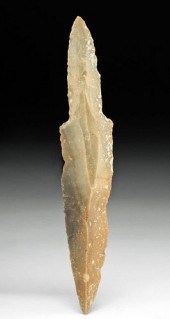 FINE BELIZE MAYA CHERT CEREMONIAL
FINE BELIZE MAYA CHERT CEREMONIAL DAGGERPre-Columbian, Belize, New River (Rio Nuevo), Maya, Late Classic Period, ca. 550 to 900 CE. An impressive hand-knapped chert stone dagger with a lengthy blade and prominent midrib. The chert is a smokey beige, black, and orange hue with speckled inclusions and mineral deposits across the surface. This type of blade was created by hitting a harder stone against the chert to flake or knap the edges to sharp points and shape the midrib and short handle extending from the shoulders. Daggers like these examples have been found at several archaeological sites throughout southern Mesoamerica and the Caribbean. Although they are called "daggers," they are often found in ritual deposits, and their forms suggest a ceremonial purpose rather than a utilitarian one. Size: 9.85" L x 1.75" W (25 cm x 4.4 cm) Provenance: private southwestern Pennsylvania, USA collection, acquired prior to 2000 All items legal to buy/sell under U.S. Statute covering cultural patrimony Code 2600, CHAPTER 14, and are guaranteed to be as described or your money back. A Certificate of Authenticity will accompany all winning bids. PLEASE NOTE: Due to recent increases of shipments being seized by Australian & German customs (even for items with pre-UNESCO provenance), we will no longer ship most antiquities and ancient Chinese art to Australia & Germany. For categories of items that are acceptable to ship to Australia or Germany, please contact us directly or work with your local customs brokerage firm. Display stands not described as included/custom in the item description are for photography purposes only and will not be included with the item upon shipping. #159983 Condition: Minor surface abrasions as expected with age and use, otherwise intact and excellent. Mineral deposits on the face.
FINE BELIZE MAYA CHERT CEREMONIAL
FINE BELIZE MAYA CHERT CEREMONIAL DAGGERPre-Columbian, Belize, New River (Rio Nuevo), Maya, Late Classic Period, ca. 550 to 900 CE. An impressive hand-knapped chert stone dagger with a lengthy blade and prominent midrib. The chert is a smokey beige, black, and orange hue with speckled inclusions and mineral deposits across the surface. This type of blade was created by hitting a harder stone against the chert to flake or knap the edges to sharp points and shape the midrib and short handle extending from the shoulders. Daggers like these examples have been found at several archaeological sites throughout southern Mesoamerica and the Caribbean. Although they are called "daggers," they are often found in ritual deposits, and their forms suggest a ceremonial purpose rather than a utilitarian one. Size: 9.85" L x 1.75" W (25 cm x 4.4 cm) Provenance: private southwestern Pennsylvania, USA collection, acquired prior to 2000 All items legal to buy/sell under U.S. Statute covering cultural patrimony Code 2600, CHAPTER 14, and are guaranteed to be as described or your money back. A Certificate of Authenticity will accompany all winning bids. PLEASE NOTE: Due to recent increases of shipments being seized by Australian & German customs (even for items with pre-UNESCO provenance), we will no longer ship most antiquities and ancient Chinese art to Australia & Germany. For categories of items that are acceptable to ship to Australia or Germany, please contact us directly or work with your local customs brokerage firm. Display stands not described as included/custom in the item description are for photography purposes only and will not be included with the item upon shipping. #159983 Condition: Minor surface abrasions as expected with age and use, otherwise intact and excellent. Mineral deposits on the face. -
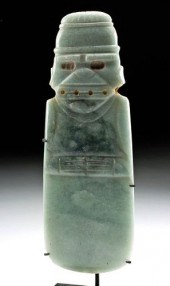 COSTA RICAN NICOYA GREENSTONE
COSTA RICAN NICOYA GREENSTONE FIGURAL AXE GOD CELTPre-Columbian, Central America, Costa Rican, Nicoya region, Atlantic Watershed, ca. 300 to 500 CE. An intriguing and abstract anthropomorphic figure known as an axe god, hand-carved from a mottled green stone with scattered dark-green inclusions. The planar figure displays string-cut and bow-drilled decorations such as eyes, teeth, nostrils, and neck line, and the lower body is a gently tapering blade edge - hence the name "axe god." The eyes are accentuated with applied red pigment that creates a wondrous effect on the orbitals. A biconically drilled suspension hole through the neck suggests this carving was worn as a pendant by the living or the dead. Size: 2.375" W x 6.75" H (6 cm x 17.1 cm); 7.6" H (19.3 cm) on included custom stand. Provenance: private New York, New York, USA collection; ex-Art for Eternity, New York, USA; ex-Skinner Auction, Marlborough, Massachusetts, USA; ex-private Los Angeles, California, USA collection All items legal to buy/sell under U.S. Statute covering cultural patrimony Code 2600, CHAPTER 14, and are guaranteed to be as described or your money back. A Certificate of Authenticity will accompany all winning bids. We ship worldwide and handle all shipping in-house for your convenience. #178892 Condition: Light abrasions, minor softening to some finer details, and some fading to pigment in eye sockets, otherwise intact and excellent. Great surface smoothness and preservation to overall form.
COSTA RICAN NICOYA GREENSTONE
COSTA RICAN NICOYA GREENSTONE FIGURAL AXE GOD CELTPre-Columbian, Central America, Costa Rican, Nicoya region, Atlantic Watershed, ca. 300 to 500 CE. An intriguing and abstract anthropomorphic figure known as an axe god, hand-carved from a mottled green stone with scattered dark-green inclusions. The planar figure displays string-cut and bow-drilled decorations such as eyes, teeth, nostrils, and neck line, and the lower body is a gently tapering blade edge - hence the name "axe god." The eyes are accentuated with applied red pigment that creates a wondrous effect on the orbitals. A biconically drilled suspension hole through the neck suggests this carving was worn as a pendant by the living or the dead. Size: 2.375" W x 6.75" H (6 cm x 17.1 cm); 7.6" H (19.3 cm) on included custom stand. Provenance: private New York, New York, USA collection; ex-Art for Eternity, New York, USA; ex-Skinner Auction, Marlborough, Massachusetts, USA; ex-private Los Angeles, California, USA collection All items legal to buy/sell under U.S. Statute covering cultural patrimony Code 2600, CHAPTER 14, and are guaranteed to be as described or your money back. A Certificate of Authenticity will accompany all winning bids. We ship worldwide and handle all shipping in-house for your convenience. #178892 Condition: Light abrasions, minor softening to some finer details, and some fading to pigment in eye sockets, otherwise intact and excellent. Great surface smoothness and preservation to overall form. -
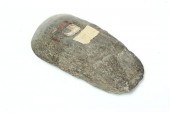 CELT. Native American. Hardstone
CELT. Native American. Hardstone with a shaped edge 7''l.
CELT. Native American. Hardstone
CELT. Native American. Hardstone with a shaped edge 7''l. -
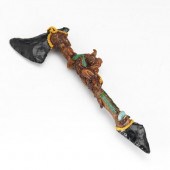 AZTEC VINTAGE TECPATL AX/KNIFE
AZTEC VINTAGE TECPATL AX/KNIFE REPRODUCTION 14 ½" x 5 ¾" Traditional Tecpatl jaguar warrior's ax/knife style with obsidian blades and clay composition figural handle, decorated in polychrome glaze and adorned with gemstones.
AZTEC VINTAGE TECPATL AX/KNIFE
AZTEC VINTAGE TECPATL AX/KNIFE REPRODUCTION 14 ½" x 5 ¾" Traditional Tecpatl jaguar warrior's ax/knife style with obsidian blades and clay composition figural handle, decorated in polychrome glaze and adorned with gemstones. -
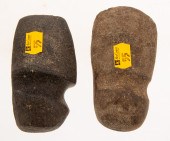 TWO NATIVE AMERICAN STONE AXE HEADS
TWO NATIVE AMERICAN STONE AXE HEADS Pre-Contact, comprising a small 3/4 groove axe, made of dark greenish-black stone, 4 7/8 in. L.; and a nearly full groove small axe made of gray stone, 5 1/4 in. L., with remnants of a collection label.
TWO NATIVE AMERICAN STONE AXE HEADS
TWO NATIVE AMERICAN STONE AXE HEADS Pre-Contact, comprising a small 3/4 groove axe, made of dark greenish-black stone, 4 7/8 in. L.; and a nearly full groove small axe made of gray stone, 5 1/4 in. L., with remnants of a collection label. -
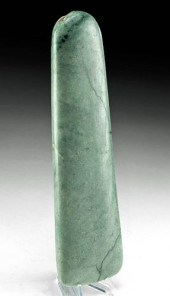 IMPRESSIVE MAYA JADE
IMPRESSIVE MAYA JADE CELTPre-Columbian, southern Mexico to Guatemala, Maya, Late Classic Period, ca. 550 to 900 CE. A beautiful example of a hand-carved jadeite celt of soft sage, pistachio, and forest green hues. The elongated trapezoidal tool features a rounded butt end for gripping, a tapered body with rounded peripheries, incredibly smooth surfaces, and an acutely-angled blade edge. The celt is a tapered hand tool of a highly stylized ritual form with ceremonial and funerary purposes. Since not all celts were created as implements of ritual sacrifice, scholars posit that many were intended to be buried as votive offerings with rulers or individuals of high wealth and social standing. Size: 9.9" L x 2.8" W (25.1 cm x 7.1 cm) Celts were associated with ears of corn, the V-shape being associated with the husk from which the cob emerged. At La Venta (a coastal city near present day Tabasco), caches of celts were discovered planted vertically like miniature stelae. The blunt end of this celt would suggest a similar use, and when placed in a vertical position its appearance is much more dramatic. In this stance, the celt served to define the central axis mundi and the corners of the four-sided world, regarded as a cosmic maize field. Provenance: ex-Marc Amiguet Schmitt estate, Amiguet's Ancient Art, Evansville, Indiana, USA, acquired prior to January 1, 2010 All items legal to buy/sell under U.S. Statute covering cultural patrimony Code 2600, CHAPTER 14, and are guaranteed to be as described or your money back. A Certificate of Authenticity will accompany all winning bids. We ship worldwide and handle all shipping in-house for your convenience. #173401 Condition: Small nicks to butt end and a few stable hairline fissures, otherwise intact and excellent. Wonderful surface smoothness throughout.
IMPRESSIVE MAYA JADE
IMPRESSIVE MAYA JADE CELTPre-Columbian, southern Mexico to Guatemala, Maya, Late Classic Period, ca. 550 to 900 CE. A beautiful example of a hand-carved jadeite celt of soft sage, pistachio, and forest green hues. The elongated trapezoidal tool features a rounded butt end for gripping, a tapered body with rounded peripheries, incredibly smooth surfaces, and an acutely-angled blade edge. The celt is a tapered hand tool of a highly stylized ritual form with ceremonial and funerary purposes. Since not all celts were created as implements of ritual sacrifice, scholars posit that many were intended to be buried as votive offerings with rulers or individuals of high wealth and social standing. Size: 9.9" L x 2.8" W (25.1 cm x 7.1 cm) Celts were associated with ears of corn, the V-shape being associated with the husk from which the cob emerged. At La Venta (a coastal city near present day Tabasco), caches of celts were discovered planted vertically like miniature stelae. The blunt end of this celt would suggest a similar use, and when placed in a vertical position its appearance is much more dramatic. In this stance, the celt served to define the central axis mundi and the corners of the four-sided world, regarded as a cosmic maize field. Provenance: ex-Marc Amiguet Schmitt estate, Amiguet's Ancient Art, Evansville, Indiana, USA, acquired prior to January 1, 2010 All items legal to buy/sell under U.S. Statute covering cultural patrimony Code 2600, CHAPTER 14, and are guaranteed to be as described or your money back. A Certificate of Authenticity will accompany all winning bids. We ship worldwide and handle all shipping in-house for your convenience. #173401 Condition: Small nicks to butt end and a few stable hairline fissures, otherwise intact and excellent. Wonderful surface smoothness throughout. -
 ARCHAIC / WOODLAND NATIVE
ARCHAIC / WOODLAND NATIVE AMERICAN STONE TOOLS (8)Native American, Midwestern United States, Ohio, Early Archaic through Woodland period, ca. 8000 BCE to 1700 CE (10,000 to 300 BP). A collection of 6 projectile points, 1 celt, and 1 hammerstone, all hand-knapped from stones. The points included are a Broad Blade point made from a pink chert, a LeCroy bifurcated point from a tan chert, a MacCorkle bifurcated point from a flint, an Intrusive Mound side notched point, a Big Sandy chert point, and a Wade type point from a gray chert. The celt is a miniature votive form, using a rare black speckled gneiss and this celt has been in some respected, old collections, including that of Agustus Wherle. The grooved hammerstone is likely from Late Woodland or Intrusive Mound cultures and is made from a river cobble. This stone object might be much older than presumed, and, if so, it might have been used as a hammer, a "skull cracker" precursor, used in later times, or even a "tie-on" atlatl weight, if not a supposed form which it closely resembles. Size of hammerstone: 4" L x 1.75" W (10.2 cm x 4.4 cm) Provenance: ex-private Saint Petersburg, Florida, USA collection; ex-private T. Beutell collection All items legal to buy/sell under U.S. Statute covering cultural patrimony Code 2600, CHAPTER 14, and are guaranteed to be as described or your money back. A Certificate of Authenticity will accompany all winning bids. PLEASE NOTE: Due to recent increases of shipments being seized by Australian & German customs (even for items with pre-UNESCO provenance), we will no longer ship most antiquities and ancient Chinese art to Australia & Germany. For categories of items that are acceptable to ship to Australia or Germany, please contact us directly or work with your local customs brokerage firm. Display stands not described as included/custom in the item description are for photography purposes only and will not be included with the item upon shipping. #167534 Condition: All are in excellent condition with mineral deposits and areas of glossy patina. Old chip to tip of axe. Some weathering from exposure to elements and use expected wear but all are intact. Scattered mineral and earthen deposits. Old inventory labels and find sites written on the surfaces of 4.
ARCHAIC / WOODLAND NATIVE
ARCHAIC / WOODLAND NATIVE AMERICAN STONE TOOLS (8)Native American, Midwestern United States, Ohio, Early Archaic through Woodland period, ca. 8000 BCE to 1700 CE (10,000 to 300 BP). A collection of 6 projectile points, 1 celt, and 1 hammerstone, all hand-knapped from stones. The points included are a Broad Blade point made from a pink chert, a LeCroy bifurcated point from a tan chert, a MacCorkle bifurcated point from a flint, an Intrusive Mound side notched point, a Big Sandy chert point, and a Wade type point from a gray chert. The celt is a miniature votive form, using a rare black speckled gneiss and this celt has been in some respected, old collections, including that of Agustus Wherle. The grooved hammerstone is likely from Late Woodland or Intrusive Mound cultures and is made from a river cobble. This stone object might be much older than presumed, and, if so, it might have been used as a hammer, a "skull cracker" precursor, used in later times, or even a "tie-on" atlatl weight, if not a supposed form which it closely resembles. Size of hammerstone: 4" L x 1.75" W (10.2 cm x 4.4 cm) Provenance: ex-private Saint Petersburg, Florida, USA collection; ex-private T. Beutell collection All items legal to buy/sell under U.S. Statute covering cultural patrimony Code 2600, CHAPTER 14, and are guaranteed to be as described or your money back. A Certificate of Authenticity will accompany all winning bids. PLEASE NOTE: Due to recent increases of shipments being seized by Australian & German customs (even for items with pre-UNESCO provenance), we will no longer ship most antiquities and ancient Chinese art to Australia & Germany. For categories of items that are acceptable to ship to Australia or Germany, please contact us directly or work with your local customs brokerage firm. Display stands not described as included/custom in the item description are for photography purposes only and will not be included with the item upon shipping. #167534 Condition: All are in excellent condition with mineral deposits and areas of glossy patina. Old chip to tip of axe. Some weathering from exposure to elements and use expected wear but all are intact. Scattered mineral and earthen deposits. Old inventory labels and find sites written on the surfaces of 4. -
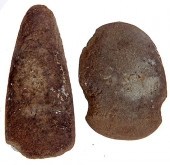 NATIVE AMERICAN STONE AXEEAST
NATIVE AMERICAN STONE AXEEAST TENNESSEE STONE AXE and celt Celt is 6" x 2"
NATIVE AMERICAN STONE AXEEAST
NATIVE AMERICAN STONE AXEEAST TENNESSEE STONE AXE and celt Celt is 6" x 2" -
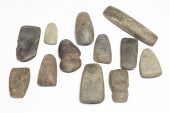 TWELVE NATIVE AMERICAN STONES AND
TWELVE NATIVE AMERICAN STONES AND TOOLS. Including grooved axes, pestle and celts. Varying wear.
TWELVE NATIVE AMERICAN STONES AND
TWELVE NATIVE AMERICAN STONES AND TOOLS. Including grooved axes, pestle and celts. Varying wear. -
 Eleven Precolumbian and
Eleven Precolumbian and Precolumbian style carved stone beads and pendants and a green jade axe head the beads include a frog several human heads and a crouching monkey; the axe head carved of dark green stone 3 3/8 in. L. Estimate $ 150-250
Eleven Precolumbian and
Eleven Precolumbian and Precolumbian style carved stone beads and pendants and a green jade axe head the beads include a frog several human heads and a crouching monkey; the axe head carved of dark green stone 3 3/8 in. L. Estimate $ 150-250 -
 Native American iron trade axe 19th
Native American iron trade axe 19th c. with a heart cut out blade 7 3/8" l. ?
Native American iron trade axe 19th
Native American iron trade axe 19th c. with a heart cut out blade 7 3/8" l. ? -
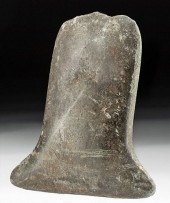 VALDIVIAN STONE AXE
VALDIVIAN STONE AXE HEAD**Originally Listed At $250** Pre-Columbian, Ecuador, Valdivia culture, ca. 3500 to 1800 BCE. A very fine stone celt or axe head that is comprised of a straight handle side and slightly flared corners with a convex body that tapers to a rounded cutting edge. The stone is a smooth, dark-gray color tinged with a hint of green. This celt was formed by pecking and grinding until smooth. The lateral projections on the handle's edge may have made this blade head easier to attached to a wooden pole or handle. Size: 5.25" L x 5" W (13.3 cm x 12.7 cm) Hand axes of this form have been found as part of the Kotosh Religious tradition, a name that archaeologists have given to ritual buildings built between 3000 and 1500 BCE in the mountain drainages of the Andes. Celts like this one, although shaped like a utilitarian tool, were made specifically for ritual purposes and were often buried with people of importance. Provenance: private southwestern Pennsylvania, USA collection, acquired prior to 2000 All items legal to buy/sell under U.S. Statute covering cultural patrimony Code 2600, CHAPTER 14, and are guaranteed to be as described or your money back. A Certificate of Authenticity will accompany all winning bids. PLEASE NOTE: Due to recent increases of shipments being seized by Australian & German customs (even for items with pre-UNESCO provenance), we will no longer ship most antiquities and ancient Chinese art to Australia & Germany. For categories of items that are acceptable to ship to Australia or Germany, please contact us directly or work with your local customs brokerage firm. Display stands not described as included/custom in the item description are for photography purposes only and will not be included with the item upon shipping. #160247 Condition: Minor abrasions and nicks noticeably scattered throughout the stone. Chipping is most prominent on the axe's bladed end commensurate with use. Overall condition is good as blade is intact with predominantly smooth surface.
VALDIVIAN STONE AXE
VALDIVIAN STONE AXE HEAD**Originally Listed At $250** Pre-Columbian, Ecuador, Valdivia culture, ca. 3500 to 1800 BCE. A very fine stone celt or axe head that is comprised of a straight handle side and slightly flared corners with a convex body that tapers to a rounded cutting edge. The stone is a smooth, dark-gray color tinged with a hint of green. This celt was formed by pecking and grinding until smooth. The lateral projections on the handle's edge may have made this blade head easier to attached to a wooden pole or handle. Size: 5.25" L x 5" W (13.3 cm x 12.7 cm) Hand axes of this form have been found as part of the Kotosh Religious tradition, a name that archaeologists have given to ritual buildings built between 3000 and 1500 BCE in the mountain drainages of the Andes. Celts like this one, although shaped like a utilitarian tool, were made specifically for ritual purposes and were often buried with people of importance. Provenance: private southwestern Pennsylvania, USA collection, acquired prior to 2000 All items legal to buy/sell under U.S. Statute covering cultural patrimony Code 2600, CHAPTER 14, and are guaranteed to be as described or your money back. A Certificate of Authenticity will accompany all winning bids. PLEASE NOTE: Due to recent increases of shipments being seized by Australian & German customs (even for items with pre-UNESCO provenance), we will no longer ship most antiquities and ancient Chinese art to Australia & Germany. For categories of items that are acceptable to ship to Australia or Germany, please contact us directly or work with your local customs brokerage firm. Display stands not described as included/custom in the item description are for photography purposes only and will not be included with the item upon shipping. #160247 Condition: Minor abrasions and nicks noticeably scattered throughout the stone. Chipping is most prominent on the axe's bladed end commensurate with use. Overall condition is good as blade is intact with predominantly smooth surface. -
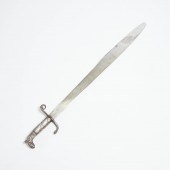 Mexican Machete Sword, Oaxaca,
Mexican Machete Sword, Oaxaca, 19th/early 20th century the 25.3 inch blade with rounded tip acid etched mottos on a chased silver-overlaid iron grip with eagle head pommel and snake form quillon and in a leather sheath overall length 31.5 in — 80 cm
Mexican Machete Sword, Oaxaca,
Mexican Machete Sword, Oaxaca, 19th/early 20th century the 25.3 inch blade with rounded tip acid etched mottos on a chased silver-overlaid iron grip with eagle head pommel and snake form quillon and in a leather sheath overall length 31.5 in — 80 cm -
 Native American iron trade axe 19th
Native American iron trade axe 19th c. with a silver inlayed heart 7" l. ?
Native American iron trade axe 19th
Native American iron trade axe 19th c. with a silver inlayed heart 7" l. ? -
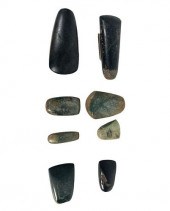 LOT 8 PRE-COLOMBIAN MAYAN JADEITE
LOT 8 PRE-COLOMBIAN MAYAN JADEITE CELT AXE BLADESA lot of 8 Pre-Colombian Mayan culture carved and polished jadeite jade stone celt axe blades of various sizes. Excavated in Guatamala. Longest blade measures approx. 3 3/4" length and shortest measures approx. 1 5/8" length. Total weight approx. 574.6 grams. Appear in overall good condition for age.
LOT 8 PRE-COLOMBIAN MAYAN JADEITE
LOT 8 PRE-COLOMBIAN MAYAN JADEITE CELT AXE BLADESA lot of 8 Pre-Colombian Mayan culture carved and polished jadeite jade stone celt axe blades of various sizes. Excavated in Guatamala. Longest blade measures approx. 3 3/4" length and shortest measures approx. 1 5/8" length. Total weight approx. 574.6 grams. Appear in overall good condition for age. -
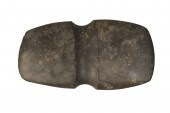 MISSISIPPI CULTURE STONE AXE
MISSISIPPI CULTURE STONE AXE HEAD, CA 1000 AD Full Groove Double-Bit Axe Head in black stone, 5" long, refined form still holding edges.
MISSISIPPI CULTURE STONE AXE
MISSISIPPI CULTURE STONE AXE HEAD, CA 1000 AD Full Groove Double-Bit Axe Head in black stone, 5" long, refined form still holding edges. -
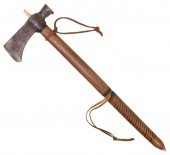 NATIVE AMERICAN STYLE TOMAHAWK AXE,
NATIVE AMERICAN STYLE TOMAHAWK AXE, 20TH/ 21ST C.Modern Native American style pipe tomahawk axe, 20th/ 21st c. walnut handle, the iron axe head approx. 2.5"h, 5.5"w, the handle with some carving, overall: 18.25"l, .95lb
NATIVE AMERICAN STYLE TOMAHAWK AXE,
NATIVE AMERICAN STYLE TOMAHAWK AXE, 20TH/ 21ST C.Modern Native American style pipe tomahawk axe, 20th/ 21st c. walnut handle, the iron axe head approx. 2.5"h, 5.5"w, the handle with some carving, overall: 18.25"l, .95lb -
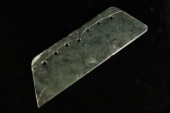 CHINESE NEOLITHIC JADE CEREMONIAL
CHINESE NEOLITHIC JADE CEREMONIAL AXE BLADE of variegated green stone bearing seven mounting holes hand drilled from both sides. With low relief carving of stylized bird form along upper edge. Lustrous polished surface with minor chips on blade edge. 13''
CHINESE NEOLITHIC JADE CEREMONIAL
CHINESE NEOLITHIC JADE CEREMONIAL AXE BLADE of variegated green stone bearing seven mounting holes hand drilled from both sides. With low relief carving of stylized bird form along upper edge. Lustrous polished surface with minor chips on blade edge. 13''
...many more examples with full details are available to our members - Learn more


